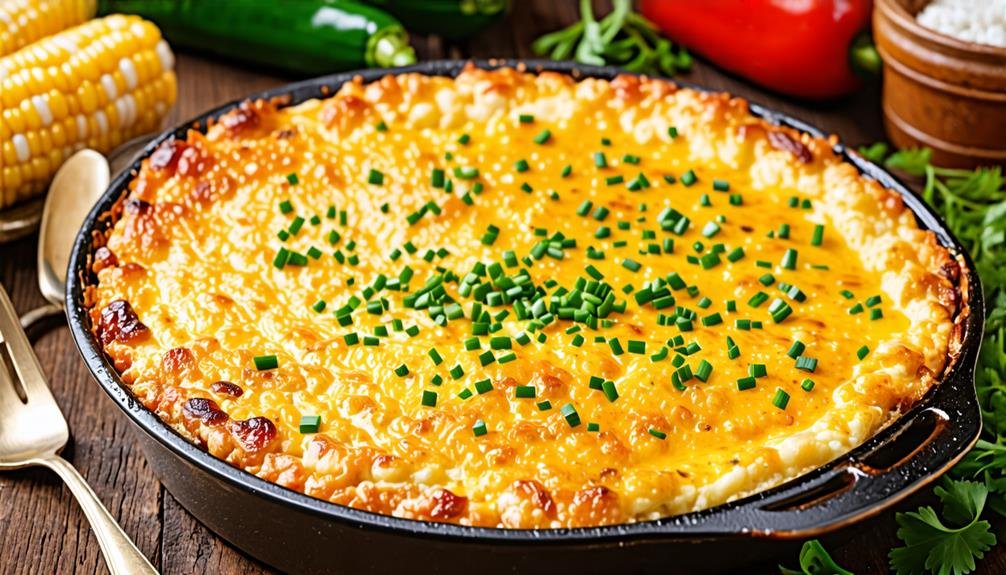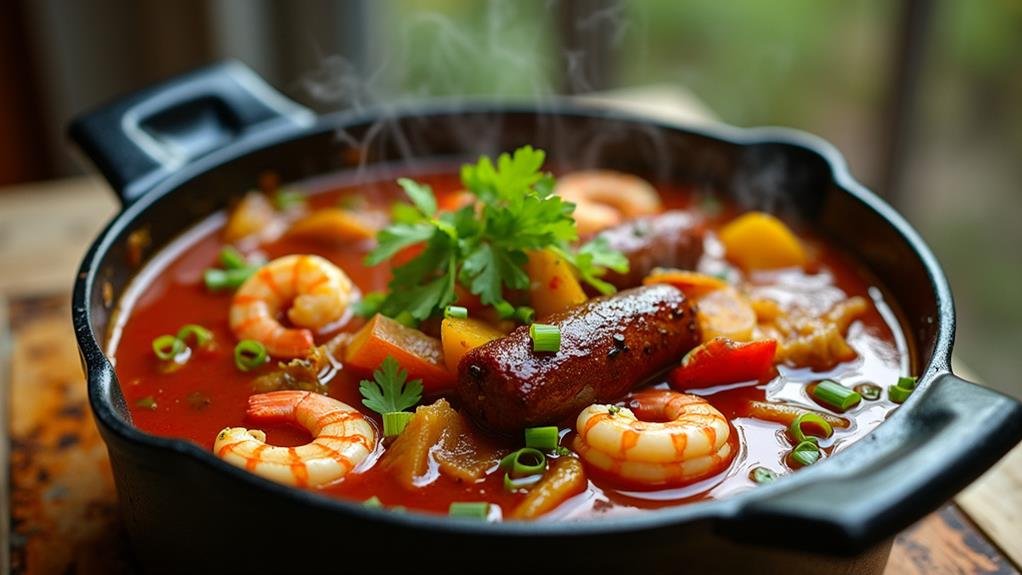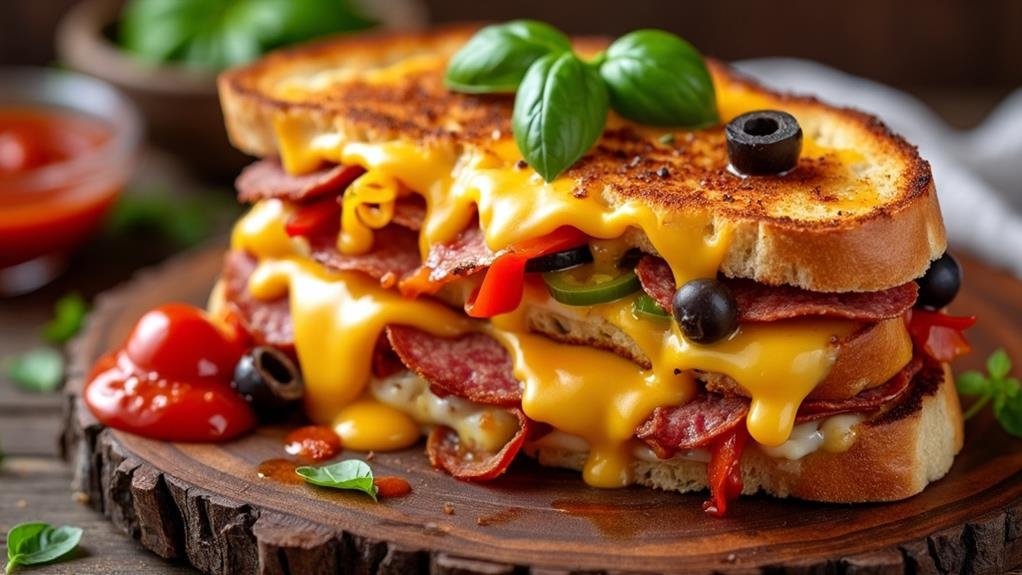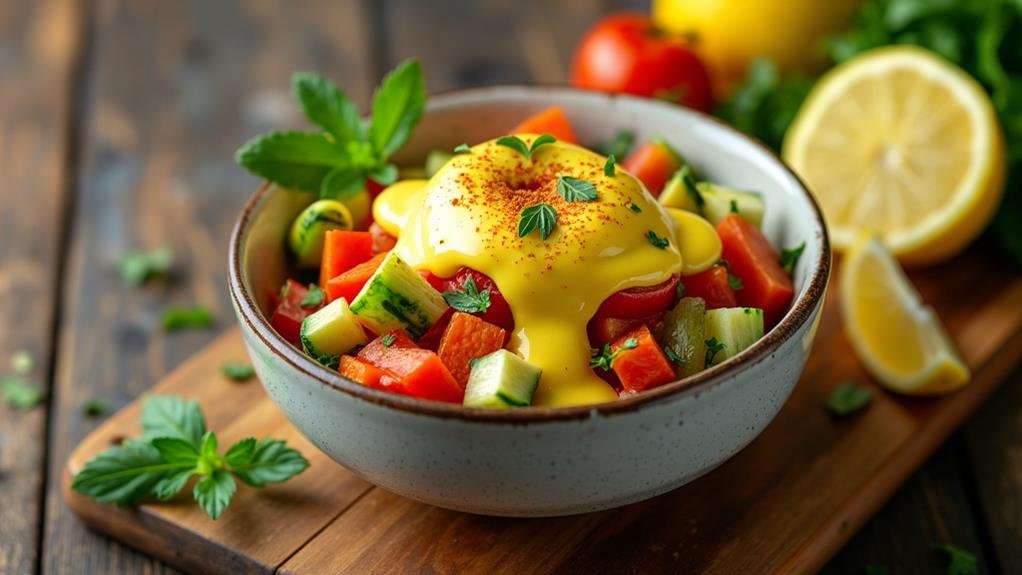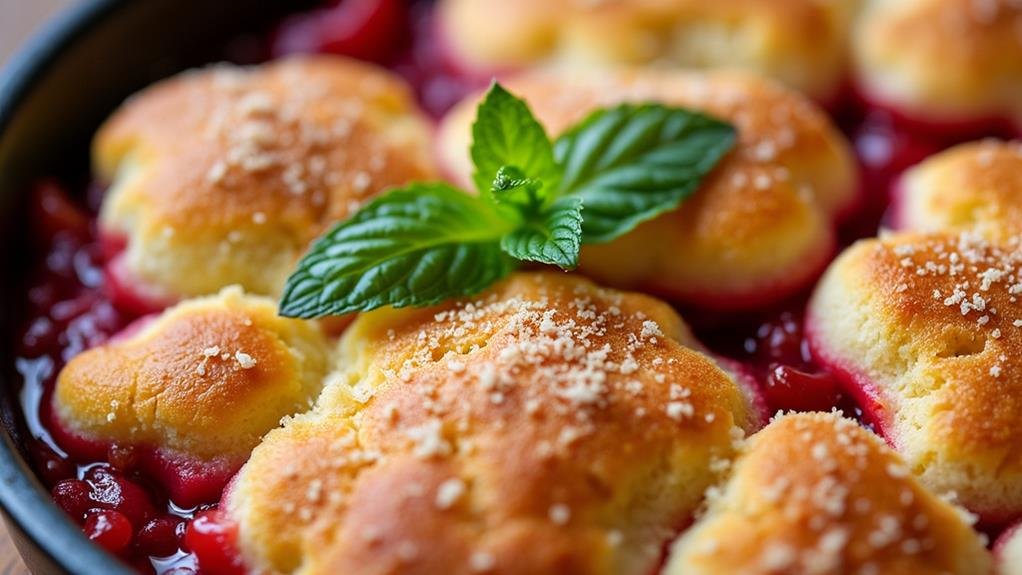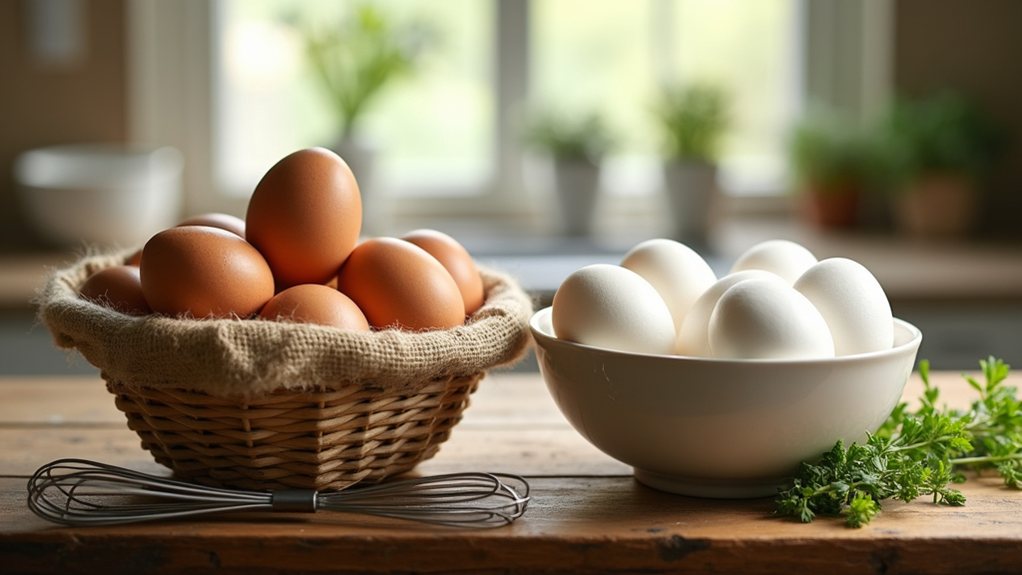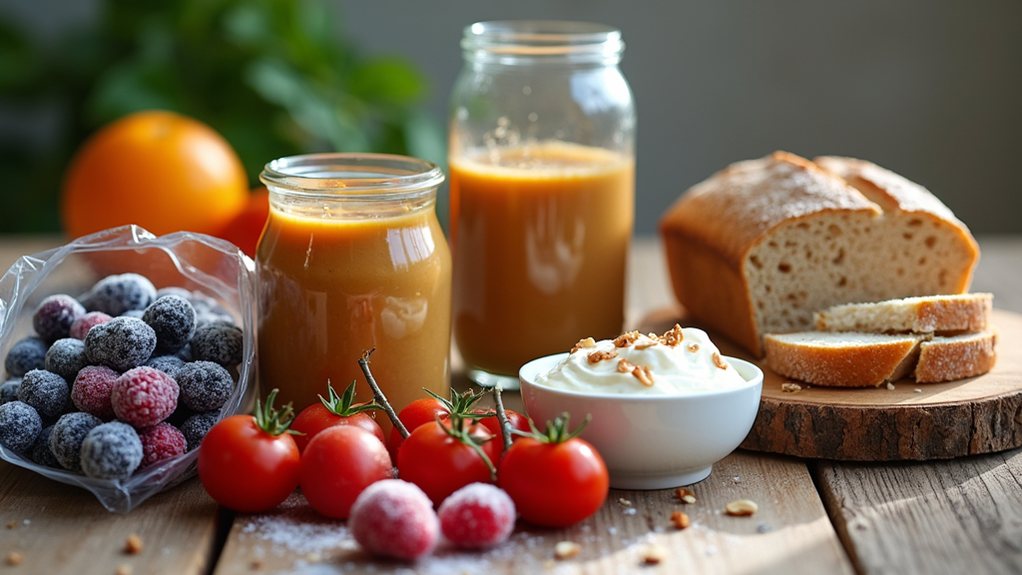Cheese grits casserole is a quintessential Southern dish that delivers a rich blend of creamy grits and savory cheeses. The core ingredients include quick-cooking grits, shredded cheddar, and Parmesan, along with seasonings and eggs for binding. Preparation involves cooking the grits, mixing in the cheeses and seasonings, and then baking until golden. This versatile casserole pairs well with fried chicken or shrimp and can be adapted with diverse herbs and flavors. Understanding the differences between grits and polenta is crucial for best results. For those keen on exploring further, additional insights into preparation variations and serving tips await.
Ingredients for Cheese Grits Casserole
To create a delicious cheese grits casserole, you need specific key components. The primary ingredient is quick-cooking grits, which provide a creamy texture. Combine these grits with water, and add unsalted butter and whole milk for richness. The hero ingredient is shredded cheddar cheese, often from brands like Kraft, which adds a bold flavor.
For seasoning, include garlic powder, kosher salt, and freshly ground black pepper to enhance the dish. Eggs act as a binding agent, giving structure to the casserole after baking. To finish, a sprinkle of grated Parmesan cheese, like that from BelGioioso, on top creates a delightful crust with a subtle nuttiness. These ingredients together create a comforting Southern classic that will satisfy your palate with every bite.
Steps to Prepare the Casserole
To prepare the cheese grits casserole, start by preheating your oven to 350°F. This temperature is essential for perfect baking. In a saucepan, bring water to a boil and whisk in quick-cooking grits. Reduce the heat and let it simmer for about five minutes, whisking often to avoid lumps.
When the grits become tender, mix in unsalted butter, milk, shredded cheddar cheese, garlic powder, salt, and black pepper. Stir until all ingredients are melted and well combined. In a separate bowl, beat an egg and then incorporate it into the grits mixture, ensuring everything is mixed thoroughly.
This dish is a classic Southern brunch option. Once the mixture is ready, pour it into a greased baking dish. This will bake into a creamy, cheesy casserole that will delight your guests. Enjoy making this comforting dish!
Serving Suggestions and Tips
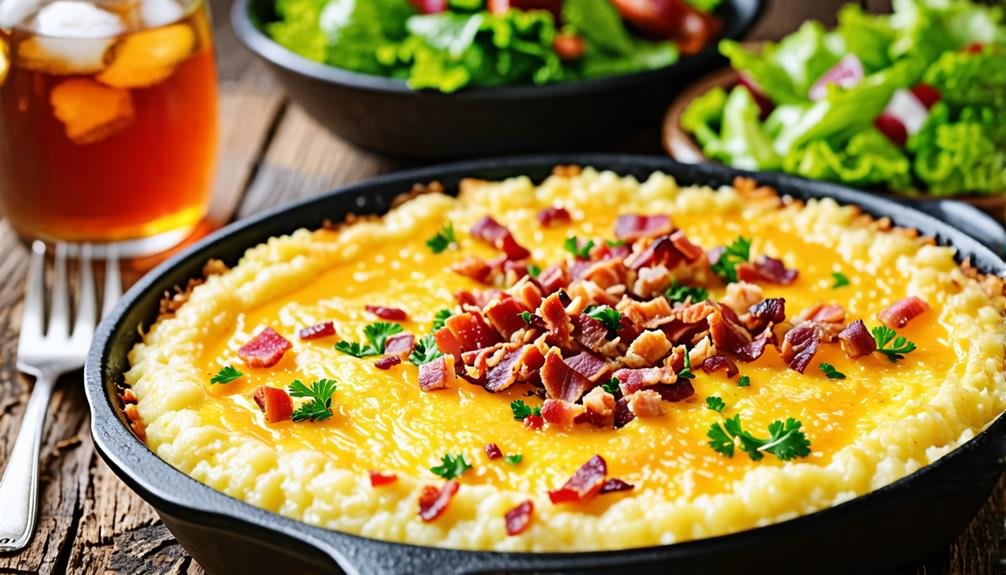
When serving cheese grits casserole, consider pairing it with proteins such as fried chicken or shrimp for a balanced meal that enriches the dish's rich flavors. Trying out different flavor variations, like incorporating herbs or unique cheese blends, can lift the casserole to new culinary heights. These suggestions not only complement the creamy texture of the grits but also offer an opportunity for creative presentation.
Pairing With Proteins
Cheese grits casserole pairs well with proteins, enriching its creamy texture. Succulent shrimp, tender chicken, and spicy sausage complement the casserole's richness. For a traditional Southern touch, serve it with fried catfish or grilled pork chops.
When choosing proteins, consider their flavors. Grilled meats contrast nicely with the casserole's creaminess, while blackened proteins add excitement. For a lighter option, poached fish aligns with the dish's comforting essence.
Incorporating proteins into the casserole can create a hearty meal. Cooked bacon or crumbled sausage mixed in infuses savory richness. For a vegetarian alternative, grilled vegetables or seasoned tofu provide satisfaction. The goal is to enhance the cheese grits casserole with proteins while maintaining its comforting character.
Flavor Variations Ideas
To enhance the flavor profile of cheese grits casserole, try adding a mix of sautéed vegetables, fresh herbs, and bold spices. Sautéed onions, bell peppers, and spinach will elevate the dish's creamy texture and cheesy richness while offering nutritional benefits.
Incorporate aromatic herbs like thyme, rosemary, or chives for a fragrant touch. For those who enjoy a bit of heat, cayenne pepper or smoked paprika can deepen the flavor. If you're adventurous, experiment with different cheeses; pepper jack can provide a spicy kick, while Gouda adds a lovely smokiness.
For a satisfying crunch, top your casserole with crispy Panko breadcrumbs or crushed Ritz crackers before baking. Pair it with a light salad to balance the richness. The beauty of cheese grits casserole lies in its adaptability, allowing you to tailor it to your taste. Get creative in the kitchen and transform this classic Southern dish into your personal favorite.
Differences Between Grits and Polenta
Understanding the differences between grits and polenta involves examining their origins, the types of corn used, and the methods of preparation. Grits, primarily associated with the American South, are made from dent corn, while polenta, a staple of Northern Italy, utilizes flint corn. Although both share similar cooking techniques, their distinct characteristics and regional significance contribute to their unique identities in culinary traditions.
Origin and Regional Varieties
Grits and polenta are both corn-based dishes, but their origins and cultural significance differ greatly. Grits, a Southern staple in the United States, stem from Native American culinary practices, where corn served as a vital food source. Traditionally made with dent corn, grits are recognized for their white hue and creamy texture, often enjoyed at breakfast or as a side dish.
In contrast, polenta is a staple from Northern Italy, cherished for centuries. This dish is primarily crafted from flint corn, giving it a yellow color and a firmer texture when prepared. While the cooking methods for both dishes involve boiling and stirring, they are shaped by their unique cultural backgrounds and culinary techniques.
Grits are typically served as a breakfast item or side, while polenta often takes center stage as a main dish or a complement to meats and vegetables. These differences not only showcase the distinct flavors and textures of each dish but also highlight the varied agricultural practices and culinary traditions across regions. Understanding these distinctions enhances appreciation for the diverse essence of Southern and Italian cuisines.
Types of Corn Used
Grits and polenta differ primarily due to the type of corn used. Grits come from dent corn, which is softer and starchier, resulting in a creamy, smooth dish. This corn variety is mainly cultivated in the United States, making grits a beloved part of Southern cuisine.
On the other hand, polenta is made from flint corn, characterized by its hard outer layer. This type of corn gives polenta a firmer texture and a richer flavor. Commonly found in Italy, where polenta originates, flint corn often has a yellow color, contrasting with the white appearance of grits. The distinct corn types not only change the taste and texture but also affect how each is cooked and served.
Both grits and polenta are versatile components in various dishes. However, the choice of corn is crucial in shaping their unique culinary identities. Recognizing these differences can enhance your cooking choices, leading to enjoyable meals.
Cooking Techniques Compared
Grits and polenta differ significantly in cooking techniques due to their unique corn varieties. Grits come from dent corn, necessitating a coarser grind and commonly prepared with salted water, leading to a creamy texture. Polenta, made from flint corn, is often yellow and can vary from coarse to fine textures.
Both require gradual mixing of grain into boiling water. However, polenta demands longer cooking times—up to an hour for optimal thickness. Grits are quicker to prepare, especially with brands like Quaker Oats offering quick-cooking options that are ready in minutes.
Both dishes serve as versatile bases or sides, accommodating various flavors and ingredients. Recognizing the differences in corn types and cooking methods allows culinary enthusiasts to appreciate the distinct characteristics of each dish, fostering creativity in the kitchen while honoring regional culinary traditions.
Choosing the Right Cornmeal
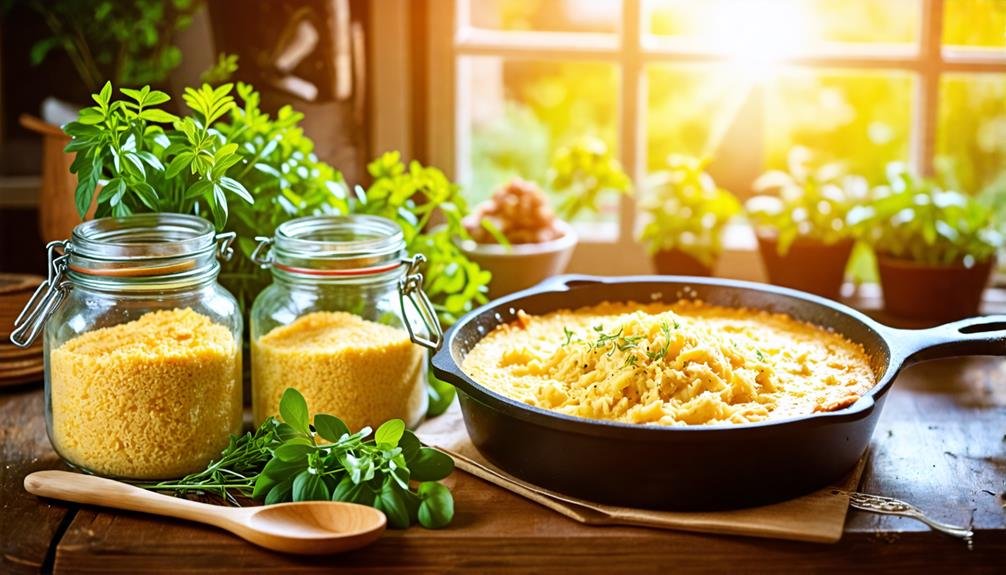
Choosing the right cornmeal is crucial for your cheese grits casserole. Cornmeal varies in type, each with distinct qualities that affect texture and flavor. Stone-ground grits, like those from Anson Mills, offer a coarse texture and deep, earthy taste, ideal for an authentic Southern dish. These grits preserve the corn's natural oils, enhancing the overall flavor.
In contrast, regular and quick-cooking grits, such as Quaker Instant Grits, provide convenience and a smoother consistency. Regular grits typically require 10 to 20 minutes to cook, while quick-cooking versions can be ready in about five minutes. However, quick-cooking options might sacrifice some flavor and nutrients due to their finer grind.
Instant grits, while easy to prepare, often suffer from excessive processing, leading to a decline in taste and texture. For the best cheese grits casserole, opt for high-quality stone-ground or regular grits to ensure authenticity and richness in this cherished Southern recipe. By recognizing these differences, you can confidently select the ideal cornmeal for your dish.
Nutritional Information Overview
Cheese grits casserole is a fulfilling dish with a caloric content of about 303 calories per serving. This savory option effectively satisfies hunger. Each serving contains approximately 19.6 grams of total fat, including 11.1 grams of saturated fat, which reflects the indulgent nature of Southern cuisine.
For those keeping track of cholesterol, this casserole offers 91.7 milligrams. On a positive note, it boasts a protein content of 13.4 grams per serving, providing lasting energy. The combination of shredded cheddar and Parmesan cheeses enhances both flavor and nutritional benefits.
For anyone desiring a comforting meal that captures the spirit of Southern cooking, cheese grits casserole provides a delightful mix of taste and nourishment. Enjoying this classic dish in moderation allows for a satisfying experience while accommodating dietary preferences. Understanding its nutritional profile enables informed choices, so you can relish every bite.

